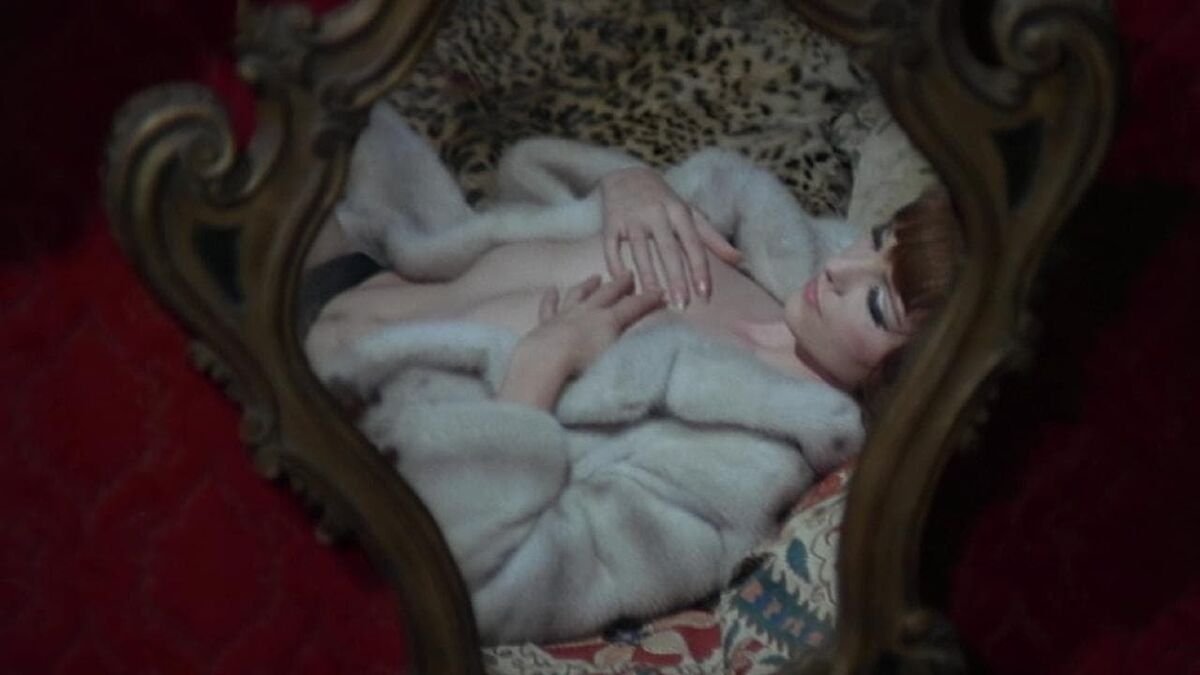Weird Wednesdays: Venus in Furs
This screening was part of the Alamo Drafthouse’s Weird Wednesday series. For upcoming shows, click here.
Venus in Furs (1969, directed by Jess Franco, not to be confused with the 2013 Roman Polanski Venus in Fur, nor any of the other approximately 100 iterations of Venus in Furs) borrows its name from the 1870 Leopold von Sacher-Masoch novella—and that’s about it. The story goes, as Elizabeth Purchell, who introduced the film, explained, that Franco originally wanted to name this film Black Angel, but to circumvent censorship renamed it so as to pass it off as a literary adaptation–much more respectable than an original erotic thriller, obviously. To tie his film to the title, Franco puts Maria Rohm, our film’s Venus, in a luxurious fur coat and has her walk around in it, striking sultry poses.
Really, that’s the underlying logic of a lot of Venus in Furs. It’s vibes over substance: and that’s jazz, baby. I’ve often seen critics and Letterboxd users compare Franco’s Venus to Vertigo, I guess because both are about a romance wherein the woman returns from the dead, sort of. I think this is unfair to Venus in Furs, because frankly, I do not think Franco has the same cinematic interests as Hitchcock. And I don’t mean that in a high art/low art, Hitchcock’s cinema to Franco’s exploitation type of way. That’s silly. Hitchcock is also doing exploitative pulp. What I mean is, every time Wanda (Maria Rohm) ambiguously murders one of her killers, Barbara McNair sings a theme song that goes “Venus in furs will be smiling…when the moment arrives.” Like, literally, every time. These are very different movies, y’all.
Also, hey, while we’re on the subject. The plot of Venus in Furs goes a little like this: Jimmy Logan (James Darren) is on a beach in Turkey. He digs a trumpet out of the sand (?) and starts playing it. Suddenly: a dead body washes up on shore—Wanda’s. A woman he met at a party, also in Turkey, and saw get murdered in a sadistic orgy by Klaus Kinski playing an Arabic playboy (?!), a lesbian fashion photographer, and some other dude who I didn’t bother to learn the name of because he’s the least interesting of the bunch and the first to die anyway, so. After discovering the dead body, he goes to Spain (?) and starts dating singer Rita, played by Barbara McNair. Then Wanda shows back up, also now in Spain (?) and everything goes to hell from there. Oh and Jimmy’s a trumpet player, also, hence the trumpet on the beach. Like I said, it’s very jazz, baby.
This is a movie that makes excellent use of the Kuleshov effect, the effect documented by Russian filmmaker Lev Kuleshov’s in the 1900s, by which, to quote Wikipedia, “viewers derive more meaning from the interaction of two sequential shots than from a single shot in isolation.” Kuleshov demonstrated this by juxtaposing the same shot of a man’s blank expression against different other shots, such as a child in a coffin or a bowl of soup. Depending on the other shot, audiences interpreted the man’s expression differently—grief for the child, hunger for the soup, etc. In Venus in Furs, Franco does something similar, by which I mean, the plot I’ve described above is less delivered by cohesive narrative structure and more derived by a series of juxtapositions that cause the mental effect of a plot happening. Wanda striding across the floor looking blankly at the camera: seductive when her victims are alive, murderous (or perhaps grief-stricken) as they orgasmically die. By her hand, sort of? We must assume, since Barbara McNair’s song more or less implies this to be so.
In the age of cinemasins, I often see an emphasis on logic over artistry or emotional resonance from the hoi polloi, on letterboxd and Twitter and so forth. And don’t get me wrong, I’m equally guilty of this–sometimes it is more fun! But. I don’t think the purpose of a film is to present a logical argument. The beauty of film is that the juxtaposition of moving image and sound can evoke meaning in a different way than its singular parts do, and that meaning need not be a sequential ordering of events that logically follow a Save The Cat style cause and effect. The beauty of Venus in Furs is watching hot women sing and do murder while a sad wet man plays the trumpet, and from the arrangement of shots and notes, we make meaning.
I like this kind of film a lot. I like to be led down ambiguous pathways. I like to be given the opportunity to pull a story out of the seams of editing on my own terms–I don’t need to be handheld as a viewer. Venus in Furs is a little bit all over the place, but I’m happy to bumble along with it. Venus in Furs will be smiling, y’all. When her moment arrives. And I will be too.



remus is a cartoonist and phd candidate at the university of florida, living in austin. their favorite movie is cats (2019). unironically. you can find them on letterboxd @threewolfmoons